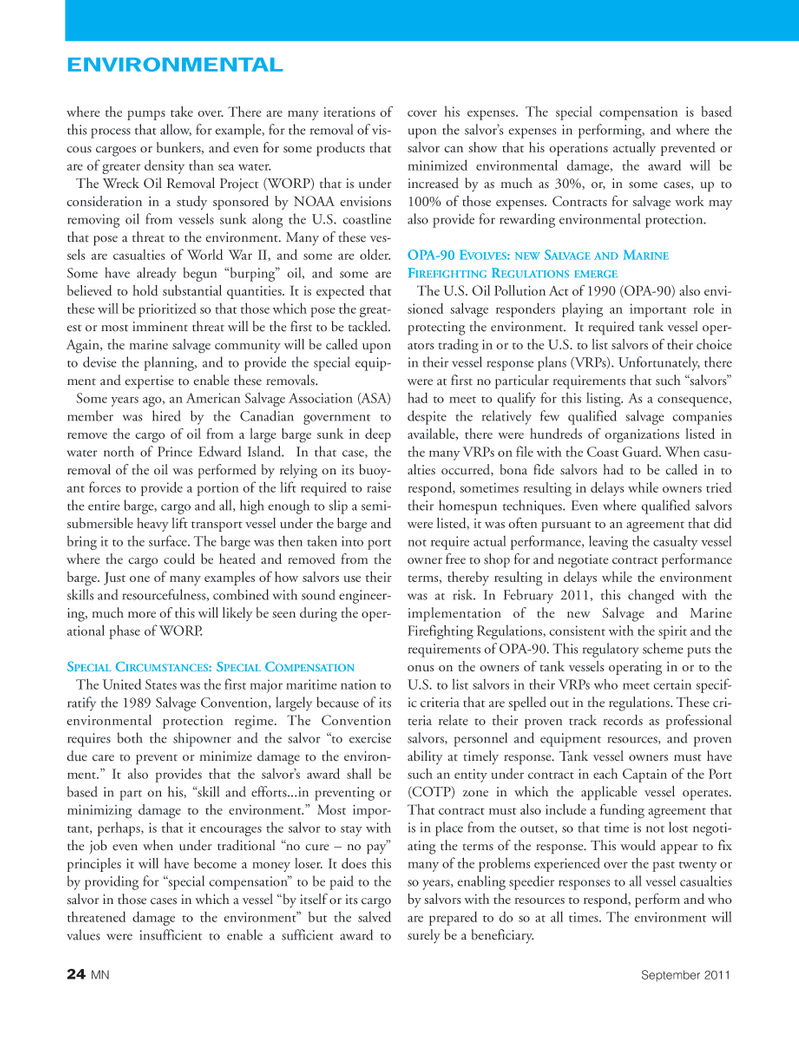
Page 24: of Marine News Magazine (September 2011)
The Environmental Edition
Read this page in Pdf, Flash or Html5 edition of September 2011 Marine News Magazine
24MNSeptember 2011where the pumps take over. There are many iterations of this process that allow, for example, for the removal of vis- cous cargoes or bunkers, and even for some products that are of greater density than sea water. The Wreck Oil Removal Project (WORP) that is under consideration in a study sponsored by NOAA envisions removing oil from vessels sunk along the U.S. coastline that pose a threat to the environment. Many of these ves- sels are casualties of World War II, and some are older. Some have already begun ?burping? oil, and some are believed to hold substantial quantities. It is expected that these will be prioritized so that those which pose the great- est or most imminent threat will be the first to be tackled. Again, the marine salvage community will be called upon to devise the planning, and to provide the special equip- ment and expertise to enable these removals. Some years ago, an American Salvage Association (ASA) member was hired by the Canadian government to remove the cargo of oil from a large barge sunk in deep water north of Prince Edward Island. In that case, the removal of the oil was performed by relying on its buoy- ant forces to provide a portion of the lift required to raise the entire barge, cargo and all, high enough to slip a semi- submersible heavy lift transport vessel under the barge and bring it to the surface. The barge was then taken into port where the cargo could be heated and removed from the barge. Just one of many examples of how salvors use their skills and resourcefulness, combined with sound engineer- ing, much more of this will likely be seen during the oper- ational phase of WORP. SPECIAL CIRCUMSTANCES : SPECIAL COMPENSATION The United States was the first major maritime nation to ratify the 1989 Salvage Convention, largely because of its environmental protection regime. The Convention requires both the shipowner and the salvor ?to exercise due care to prevent or minimize damage to the environ- ment.? It also provides that the salvor?s award shall be based in part on his, ?skill and efforts...in preventing or minimizing damage to the environment.? Most impor- tant, perhaps, is that it encourages the salvor to stay with the job even when under traditional ?no cure ? no pay? principles it will have become a money loser. It does this by providing for ?special compensation? to be paid to the salvor in those cases in which a vessel ?by itself or its cargo threatened damage to the environment? but the salved values were insufficient to enable a sufficient award to cover his expenses. The special compensation is based upon the salvor?s expenses in performing, and where the salvor can show that his operations actually prevented or minimized environmental damage, the award will be increased by as much as 30%, or, in some cases, up to 100% of those expenses. Contracts for salvage work may also provide for rewarding environmental protection. OPA-90 E VOLVES : NEW SALVAGEAND MARINEFIREFIGHTINGREGULATIONSEMERGE The U.S. Oil Pollution Act of 1990 (OPA-90) also envi- sioned salvage responders playing an important role in protecting the environment. It required tank vessel oper- ators trading in or to the U.S. to list salvors of their choice in their vessel response plans (VRPs). Unfortunately, there were at first no particular requirements that such ?salvors? had to meet to qualify for this listing. As a consequence,despite the relatively few qualified salvage companies available, there were hundreds of organizations listed in the many VRPs on file with the Coast Guard. When casu- alties occurred, bona fide salvors had to be called in to respond, sometimes resulting in delays while owners tried their homespun techniques. Even where qualified salvors were listed, it was often pursuant to an agreement that did not require actual performance, leaving the casualty vessel owner free to shop for and negotiate contract performance terms, thereby resulting in delays while the environment was at risk. In February 2011, this changed with the implementation of the new Salvage and Marine Firefighting Regulations, consistent with the spirit and the requirements of OPA-90. This regulatory scheme puts the onus on the owners of tank vessels operating in or to the U.S. to list salvors in their VRPs who meet certain specif- ic criteria that are spelled out in the regulations. These cri- teria relate to their proven track records as professional salvors, personnel and equipment resources, and proven ability at timely response. Tank vessel owners must have such an entity under contract in each Captain of the Port (COTP) zone in which the applicable vessel operates. That contract must also include a funding agreement that is in place from the outset, so that time is not lost negoti- ating the terms of the response. This would appear to fix many of the problems experienced over the past twenty or so years, enabling speedier responses to all vessel casualties by salvors with the resources to respond, perform and who are prepared to do so at all times. The environment will surely be a beneficiary. ENVIRONMENTAL MN#9 (18-31):MN 2011 Layouts 9/6/2011 4:19 PM Page 24

 23
23

 25
25
